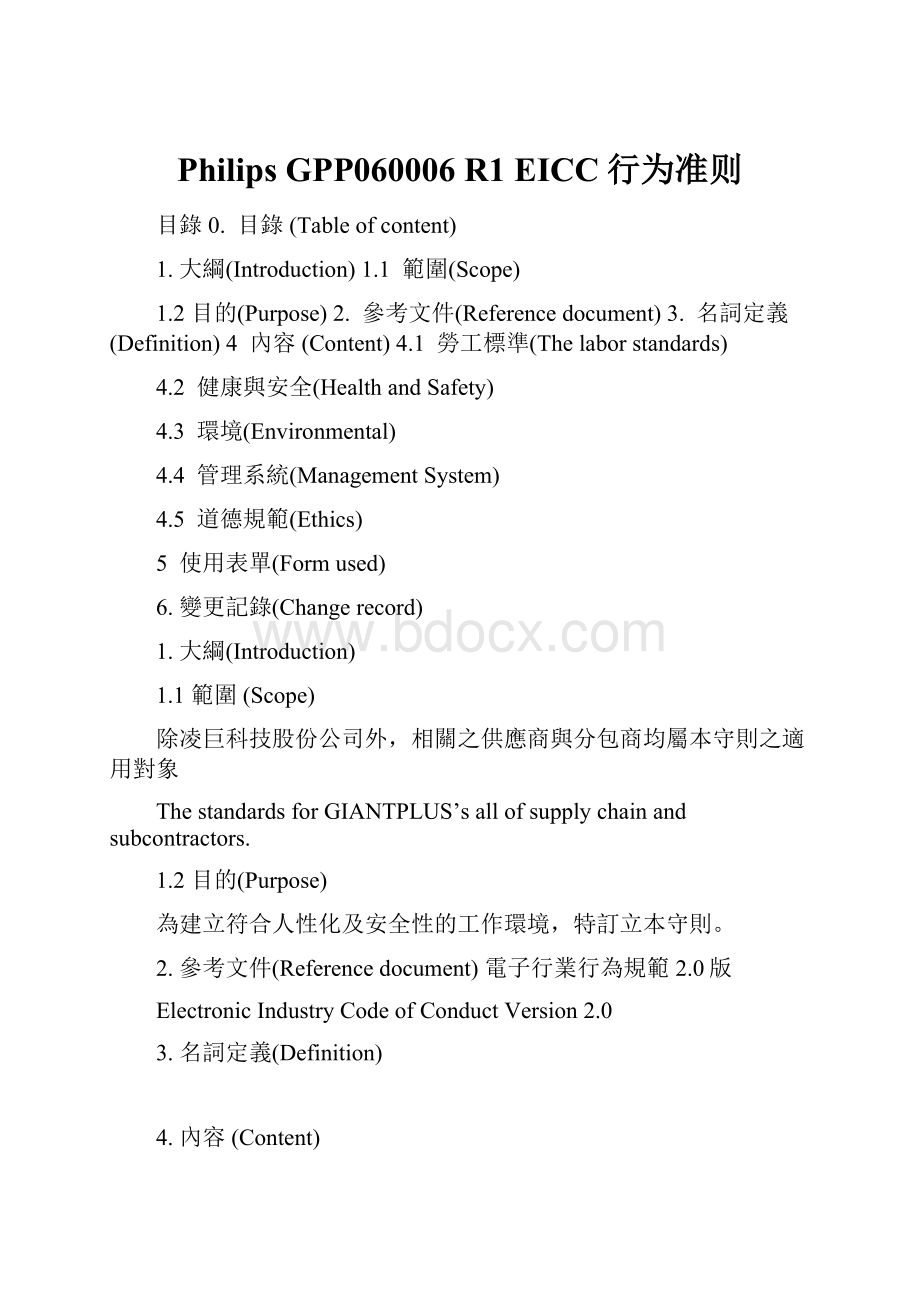Philips GPP060006 R1 EICC行为准则.docx
《Philips GPP060006 R1 EICC行为准则.docx》由会员分享,可在线阅读,更多相关《Philips GPP060006 R1 EICC行为准则.docx(11页珍藏版)》请在冰豆网上搜索。

PhilipsGPP060006R1EICC行为准则
目錄0.目錄(Tableofcontent)
1.大綱(Introduction)1.1範圍(Scope)
1.2目的(Purpose)2.參考文件(Referencedocument)3.名詞定義(Definition)4內容(Content)4.1勞工標準(Thelaborstandards)
4.2健康與安全(HealthandSafety)
4.3環境(Environmental)
4.4管理系統(ManagementSystem)
4.5道德規範(Ethics)
5使用表單(Formused)
6.變更記錄(Changerecord)
1.大綱(Introduction)
1.1範圍(Scope)
除凌巨科技股份公司外,相關之供應商與分包商均屬本守則之適用對象
ThestandardsforGIANTPLUS’sallofsupplychainandsubcontractors.
1.2目的(Purpose)
為建立符合人性化及安全性的工作環境,特訂立本守則。
2.參考文件(Referencedocument)電子行業行為規範2.0版
ElectronicIndustryCodeofConductVersion2.0
3.名詞定義(Definition)
4.內容(Content)
4.1勞工標準(Thelaborstandards)
4.1.1自由選擇職業(FreelyChosenEmployment)
公司禁止使用任何形式的強迫勞動,包括監獄勞工、契約勞工及抵債勞工等。
所有工作應是自願的,並且員工在當地法律/法規所規定的情形下,有自由離職的權利。
公司禁止採用任何限制勞動自由的行為,如扣押身份證證件。
收取押金或抵押物、扣押工人工資、使用監視或監聽器、強迫搜身、限制工人出入工廠和強迫加班等。
Forcedbondedorindenturedlabororinvoluntaryprisonlaborisnottobeused.Allworkwillbevoluntary,andworkersshouldbefreetoleaveuponreasonablenotice.Workersshallnotberequiredtohandovergovernment-issuedidentification,passportsorworkpermitsasaconditionofemployment.
4.1.2避免使用童工(ChildLaborAvoidance)
在營運中任何階段都不能使用童工,不與任何故意使用童工的供應商合作。
此處”童工”年齡標準的定義,依當地政府法律之規定。
Nopersonbelowtheageof16isemployedbythesupplier,ifthelocallegalminimumageforworkishigherthan16,thesupplieremploysnooneyoungerthanthelegalminimumage.
4.1.3工作時間(Workinghours)
每月工作時間以及加班時間均不應超過當地法規規定的最大限度。
(每週七天中應允許員工至少休息一天。
)
Monthlyworkinghoursarenottoexceedthemaximumsetbylocallaw.Further,overtime,mustbefollowthelawofgovernment.
4.1.4薪資與福利(WagesandBenefits)
支付給員工的工資應符合所有適用的工資法律/法規,包括與最低工資、加班時間和法定福利有關的法律/法規。
得依據當地法律/法規規定,以高於平時費率的加班費率來支付員工加班工資。
不得允許有任何懲戒性的工資扣除。
Allemployeesofthesuppliershallreceivethegreaterofthelegalminimumwageandbenefitsortheprevailingwageandbenefitsintheindustry,withawrittenaccountinggiventotheemployeeduringeachpayperiodclearlyindicatingtheemployee’scompensationandindicatinganydeductionsfromtheemployee’spay,supplieragreestopayhigherhourlyratesforlateshiftsthanfornormalshifts,thesuppliermaynotdeductpenaltiesfordisciplinaryinfractionsfromemployeewages.
4.1.5人性化待遇(HumaneTreatment)
不得對員工實施殘酷和不人道的待遇,包括任何性騷擾、性虐待、體罰、精神或身體脅迫、或者口頭辱罵員工;也不得威脅使用任何此類待遇。
Thereistobenoharshandinhumanetreatment,includinganysexualharassment,sexualabuse,corporalpunishment,mentalorphysicalcoercionorverbalabuseofworkers:
noristheretobethethreatofanysuchtreatment.
4.1.6不歧視(Non-discrimination)
公司不得因種族、膚色、年齡、性別、性取向、人種、殘疾、懷孕、信仰、政治派別、社團成員或者婚姻狀況等在招聘及雇用(如晉升、獎賞和受培訓等)中歧視員工。
另外,所有員工不得遭受歧視性的醫學檢查。
Companiesshallnotengageindiscriminationbasedonrace,color,age,gender,sexualorientation,ethnicity,disability,pregnancy,religion,politicalaffiliation,unionmembershipormaritalstatusinhiringandemploymentpracticessuchaspromotions,rewards,andassesstotraining.Inaddition,workersorpotentialworkersshouldnotbesubjectedtomedicalteststhatcouldbeusedinadiscriminatoryway.
4.1.7自由結社(FreedomofAssociation)
員工與管理層之間的公開溝通和直接參與是解決工作場所問題和報酬問題的最有效的方法。
工司應尊重員工參加或不參加勞工組織、集體談判的權利。
依照法律規定,員工代表不得受到歧視,並有權和管理層、同事接觸以實現他們代表的職能。
員工應能夠公開地就工作條件和管理層溝通,而不擔心報復、威脅、騷擾。
Opencommunicationanddirectengagementbetweenworkersandmanagementarethemosteffectivewaystoresolveworkplaceandcompensationissues.Businessaretorespecttherightsofworkersasjoinornotjoinlaborunionsandbargaincollectivelyastheychoose.Asprovidedbylaw,employeeswhobecomeworkerrepresentativesshallnotbethesubjectofdiscriminationandshallhaveaccesstomanagementandco-workersinordertocarryouttheirrepresentativefunctions.Workersshallbeabletocommunicateopenlywithmanagementregardingworkingconditionswithoutfearofreprisal,intimidationorharassment.
4.2健康與安全(HealthandSafety)
4.2.1職業安全(OccupationalSafety)
對員工接觸到的工作場所存在的潛在危險源(如電器和其它能源、火、車輛、滑倒、絆倒和掉落危險源),須通過正確地設計、工程技術及管理控制、預防保養和安全操作程式(包括鎖死/標示)加以管制,在危險源不能被如上方法完全控制時,應該給員工提供適當的個人防護用品,不得通過懲戒來提升員工的安全意識。
Workerexposuretopotentialsafetyhazards(e.g.electricalandotherenergysources,fire,vehicle,andfallhazards)aretobecontrolledthroughproperdesignengineeringandadministrativecontrols,preventativemaintenanceandsafeworkprocedure(includinglockout/mark).Wherehazardscannotbeadequatelycontrolledbythesemeans,workersaretobeprovidedwithappropriatepersonalprotectiveequipment.Workersshallnotbedisciplinedforraisingsafetyconcerns.
4.2.2緊急應變與回應(EmergencyPreparedness)
應識別和評估緊急情況和事件,通過實施應急計畫和回應程式來將其影響降低到最小程度,包括:
緊急通報、通知員工和徹離步驟、員工培訓和演練、適當的火災探測和抑制設備、充份的出口設施以及恢復計畫。
Emergencysituationsandeventsaretobeidentifiedandassessed,andtheirimpactminimizedbyimplementingemergencyplansandresponseprocedures,including:
emergencyreporting,employeenotificationandevacuationprocedures,workertraininganddrills,appropriatefiredetectionandsuppressionequipment,adequateexitfacilitiesandrecoveryplans.
4.2.3職業傷害和疾病
制訂程式和系統來管理、追蹤和預防職業傷害和疾病,如:
歸類和記錄傷害和疾病案例;提供必要的治療與健康檢查;瞭解發生原因並執行糾正措施以消除其原因;幫助員工返回工作。
Procedureandsystemsaretobeinplacetomanage,trackandreportoccupationalinjuryandillness,includingprovisionsto:
a)encourageworkerreporting;b)classifyandrecordinjuryandillnesscases;c)providenecessarymedicaltreatment;d)investigatecasesandimplementcorrectiveactionstoeliminatetheircauses;andd)facilitatereturmofworkerstowork.
4.2.4工業衛生(IndustrialHygiene)
應識別、評估和控制由化學、生物以及物理因素給員工帶來的影響。
當通過工程技術和管理手段無法充分控制危險時,應為作業人員提供適當的個人防護用品。
Workerexposuretochemical,biologicalandphysicalagentsistobeidentified,evaluated,andcontrolled.Whenhazardscannotbeadequatelycontrolledbyengineeringandadministrativemeans,workersaretobeprovidedwithappropriatepersonalprotectiveequipment.
4.2.5體力勞動(PhysicallyDemandingWork)
應識別、評估和控制從事體力勞動給員工帶來的影響,包括人工搬運材料和舉起重物、長時間站立和高度重複或者高強度的裝配工作。
Workerexposuretophysicallydemandingtasks,includingmanualmaterialhandingandheavylifting,prolongedstandingandhighlyrepetitiveorforcefulassemblytasksistobeidentified,evaluatedandcontrolled.
4.2.6機器的安全防護(MachineSafeguarding)
應為作業人員所使用的機械提供物理防護裝置、聯動裝置以及屏障,並正確地進行維護。
Physicalguards,interlocksandbarriersaretobeprovidedandproperlymaintainedformachineryusedbyworkers.
4.2.7宿舍和餐廳(DormitoryandCanteen)
應為員工提供乾淨的衛生間設施、可飲用的水及清潔衛生的食品預備和存儲設施。
提供的員工宿舍應乾淨、安全,並提供緊急出口及合理的私人空間。
Workersaretobeprovidedwithcleantoiletfacilities,accesstopotablewaterandsanitaryfoodpreparationandstoragefacilities.WorkerdormitoriesprovidedbytheBusinessoralaboragentaretobeclean,safe,andprovideemergencyegress,adequateheatandventilationandreasonablepersonalspace.
4.3環境(Environmental)
在營運過程中,對環境和自然資源的不利影響應減至最小,同時保護公共的健康和安全。
InBusinessoperations,adverseeffectsonthecommunity,environmentandnaturalresourcesaretobeminimizedwhilesafeguardingthehealthandsafetyofthepublic.
4.3.1環境許可和報告(EnvironmentalPermitsandReporting)
應獲得所有要求的環境許可(如排污許可)並登記、維護和保持其現行有效,遵守其操作和報告要求。
Allrequiredenvironmentalpermits(e.g.dischargemonitoring)andregistrationsaretobeobtained,maintainedandkeptcurrentandtheiroperationalandreportingrequirementsaretobefollowed.
4.3.2污染預防和資源節約(PollutionPreventionandResourceReduction)
應在源頭或者通過實踐(如更改生產、維護和設施工藝、替換材料、節約自然資源、再生和重複使用材料)減少或者消除所有類型的資源耗費,包括水和能源。
Wasteofalltypes,includingwaterandenergy,aretobereducedoreliminatedatthesourcerbypracticessuchasmodifyingproduction,maintenanceandfacilityprocesses,materialssubstitution,conservation,recyclingandre-usingmaterials.
4.3.3有害物質(HazardousSubstances)
應識別和管理化學物質以及其它釋放到環境中會造成危險的其他物質,以確保其安全處理、運輸、貯存、再生或者重複使用和處置。
Chemicalandothermaterialsposingahazardifreleasedtotheenvironmentaretobeidentifiedandmanagedtoensuretheirsafehanding,movement,storage,recyclingorreuseanddisposal.
4.3.4廢水和固體廢棄物(WastewaterandSolidWaste)
在排放或者處置之前,應按照要求監測、控制和處理:
經營、工業加工以及衛生設施中所產生的廢水和固體廢棄物。
Wastewaterandsolidwastegeneratedfromoperations,industrialprocessesandsanitationfacilitiesaretobemonitored,controlledandtreatedasrequiredpriortodischargeordisposal.
4.3.5空氣排放(AirEmissions)
在排放之前,應按照要求表徵、監視、控制和處理經營中產生的揮發性有機化學藥品、氣霧劑、腐蝕劑、微粒、臭氧消耗化學藥品以及燃燒副產品的空氣排放。
產品生產操作中產生的揮發性的有機化學物質、煙霧、腐蝕性物質、粉塵、消耗臭氧層化學物和燃燒廢氣,應在排放前鑑別其特性,並進行監測、控制和處理。
Airemissionsofvolatileorganicchemicals,aerosols,corrosives,particulates,ozonedepletingchemicalsandcombustionby-productsgeneratedfromoperationsaretobecharacterized,monitored,controlledandtreatedasrequiredpriortodischarge.
4.3.6產品含量限制(ProductContentRestrictions)
公司應遵守所有有關禁止或者限制特定物質所適用的法律/法規,包括有關再生和處置標籤的法律/法規。
公司還應該通過管控制造過程來符合客戶對限制有害物質管控的要求。
Businessaretoadheretoallapplicablelawsandregardingprohibitionorrestrictionofspecificsubstancesincludinglawsandregulationsforrecyclinganddisposal.Businessarealsotoadheretoprocessestocomplywitheachagreed-uponcustomer-specificrestrictedandhazardousmateriallist.
4.4管理系統(ManagementSystem)
公司應建立一套管理系統,以確保其經營和所生產的產品,能符合法令與客戶要求,並能持續改進。
該管理系統應包含以下要素:
Businessshalladoptorestablishamanagementsystem.Themanagementsystemshallbedesignedtoensurecompliancewithapplicablelaws,regulationsandcustomerrequirementsrelatedtotheBusiness’soperationsandproducts.Itshouldalsofacilitatecontinualimprovement.Themanagementsystemshouldcontainthefollowingelements:
4.4.1公司承諾(CompanyCommitment)
公司應訂立環境及社會責任宣言,以供遵守。
CorporatesocialandenvironmentalresponsibilitystatementsaffirmingBusiness’scommitmenttocomplianceandcontinualimprovement.
4.4.2管理職責與責任(ManagementAccountabilityandResponsibility)
公司應設置管理代表,以確保本管理系統的運行。
Clearlyidentifiedcompanyrepresentativesresponsiblefor